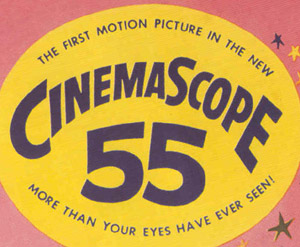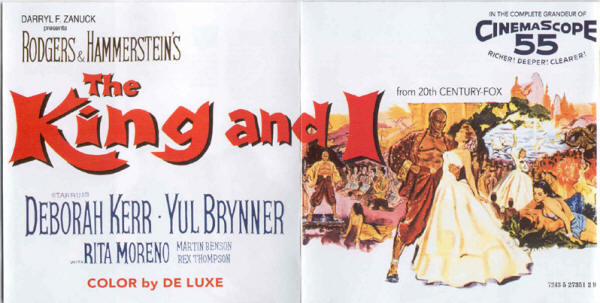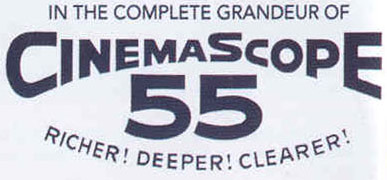"Carousel" screening |
Read more
at in70mm.com The 70mm Newsletter |
| Written by: Rick Mitchell Film Editor/ Film Director/ Film Historian. With a comment from Bill Taylor | Date: 17 May 2005 |
 A beautiful restored 35mm print of "Carousel" (20th Century-Fox; 1956) was
shown at its original 2.55:1 aspect ratio at the Academy of Motion Picture
Arts and Sciences' Samuel Goldwyn Theater on Apr. 22, 2005. Unfortunately,
the evening's "host", critic Stephen Farber, displayed the technical
ignorance of most of the practitioners of his craft by confusing the
"aspect ratio" with the "original negative format", implying that the
audience would be seeing a "55mm print." A beautiful restored 35mm print of "Carousel" (20th Century-Fox; 1956) was
shown at its original 2.55:1 aspect ratio at the Academy of Motion Picture
Arts and Sciences' Samuel Goldwyn Theater on Apr. 22, 2005. Unfortunately,
the evening's "host", critic Stephen Farber, displayed the technical
ignorance of most of the practitioners of his craft by confusing the
"aspect ratio" with the "original negative format", implying that the
audience would be seeing a "55mm print."In fact, though 55mm prints were never made on either "Carousel" or its successor "The King and I", both were shown at 2.55:1 in their premiere engagements in Los Angeles and New York and in any other theaters that still showed magnetic only CinemaScope prints at 2.55:1. The optical track cut down the width of the image, resulting in a ratio of 2.35:1. By early 1956, because some companies, notably Allied Artists and United Artists, were releasing CinemaScope pictures only with optical tracks, as well as MGM's starting to release combined "mag-optical" prints in December, 1955, a practice soon followed by Warner Bros., many first, and especially second run theaters had begun running all CinemaScope pictures at 2.35:1. By mid-summer 1954, all film companies were composing their CinemaScope pictures to make certain that there was no important action on the left side of the frame that might be cut off by an optical track, and generally for better looking compositions when the films were projected at 2.35:1. However, CinemaScope 55 was intended for projection at 2.55:1 and this is obvious from how great the compositions of "Carousel" looked on the big, wide Goldwyn Theater screen. Even closeups are compositionally balanced. Ironically, given Fox's intent in developing CinemaScope 55, sharper, higher image quality, the results were not quite satisfying as far as "Carousel" goes. (I had to miss the screening of the restored "The King and I" last August but recall previous prints as having very high resolution.) Many scenes, particularly full and long shots, were not that sharp, even in exteriors shot in bright sunlight; admittedly the ASA of the film stock was very low, about 10. Though, because of the condition of the negative, the film had been put through a Digital Intermediate at 4K resolution, this was not the reason for the poorer resolution as original negative grain was detectable from third row center where Dan Sherlock and I were sitting. This also does not resolve the 4K vs. 2K issue for Digital Intermediates from anamorphic negatives. As I've mentioned before, every anamorphic film that's been put through a 2K DI that I've seen to date has looked awful. On the other hand, the color is brilliant and vivid, perfectly capturing the look of Fox films printed by De Luxe in the Fifties, a look I remember finding more pleasing than that of Technicolor at the time. (Do I hear a disturbance in the Farce?) |
Further
in 70mm reading: CinemaScope 55 CinemaScope 55 CinemaScope 55 |
 As it turns out, "Carousel" did not have a particularly striking stereo dub,
though there was both a six and a four track version, from both of which
the track of this restoration was derived. Apparently there was no use of
surrounds, which was actually typical of the time and the source of
complaints from those exhibitors who'd put in surround speakers.
Actress-dancer Susan Luckey, who played the teenage daughter of Gordon
MacRae and Shirley Jones, confirmed that because of the noise of the
cameras, the entire film was looped. Yet the film has a natural track
especially in the scenes shot on stages. There is a surprising amount of
foley, even in some of the musical numbers and the dialog has the
spaciousness of production recording rather than the often hollow sound of
a looping/ADR stage, though some of this may have been the result of
cleaning up the track during the restoration. There is some movement of
dialog between the front speakers as the characters move from one position
to another. This print, like that of "The King and I", carried only a Dolby
Digital track so that it could be screened at 2.55.1. Fox is currently
preparing dupe negatives on both films in which the 2.55:1 frame would be
reduced to fit into a 2.35/2.40:1 frame so that a stereo variable area
optical track and maybe DTS time code can be added to allow the films to
be shown at the proper ratio in theaters which don't have the screen width
to properly show 2.55:1. As it turns out, "Carousel" did not have a particularly striking stereo dub,
though there was both a six and a four track version, from both of which
the track of this restoration was derived. Apparently there was no use of
surrounds, which was actually typical of the time and the source of
complaints from those exhibitors who'd put in surround speakers.
Actress-dancer Susan Luckey, who played the teenage daughter of Gordon
MacRae and Shirley Jones, confirmed that because of the noise of the
cameras, the entire film was looped. Yet the film has a natural track
especially in the scenes shot on stages. There is a surprising amount of
foley, even in some of the musical numbers and the dialog has the
spaciousness of production recording rather than the often hollow sound of
a looping/ADR stage, though some of this may have been the result of
cleaning up the track during the restoration. There is some movement of
dialog between the front speakers as the characters move from one position
to another. This print, like that of "The King and I", carried only a Dolby
Digital track so that it could be screened at 2.55.1. Fox is currently
preparing dupe negatives on both films in which the 2.55:1 frame would be
reduced to fit into a 2.35/2.40:1 frame so that a stereo variable area
optical track and maybe DTS time code can be added to allow the films to
be shown at the proper ratio in theaters which don't have the screen width
to properly show 2.55:1.For the historical record, CinemaScope 55 was Fox's response to demonstrations of Todd-AO held on MGM's Stage 30 in the Spring of 1954. As is well known and was being constantly argued at the time, standard 35mm CinemaScope was not sharp, but then again, neither were non-anamorphic films being masked off and projected on large screens at aspect ratios as narrow/wide as 1.85:1 and even 2:1. This was Paramount's argument in pushing VistaVision. Although Todd-AO was conceived as a prestige roadshow format, Mike Todd's "Cinerama-out-of-one-hole", and at the time, the only way to do a 35mm general release of a Todd-AO film was to shot a concurrent CinemaScope version (which was done only with "Oklahoma!"), it was inevitable that a method of reduction printing and speed conversion would be developed (initially filming in 65mm at two speeds, later reducing the rate from 30 to 24 fps), resulting in higher quality and resolution 35mm anamorphic prints. |
|
 Beyond a desire to be different from Todd-AO, exactly why Fox chose a
width of 55.625mm is a subject for further research, especially since the
same 70 and 65mm cameras from 1930 were modified for use in both
processes. CinemaScope 55 kept the basically square frame, expanding it to
a height of eight perfs. The original intention was to make 55mm prints
with the image reduced to a height of six perfs. to allow for six tracks
of magnetic sound, similar to Todd-AO's and the reason for the six track
dub ("The King and I"'s was only a 4 track). There was some question about
whether or not good 35mm reduction prints could be made, which is why the
first week's work was done in both 55 and 35mm until Darryl Zanuck saw a
reduction print he was satisfied with. (This situation did cost them
original star Frank Sinatra.) Unfortunately, the 55mm projectors were not
ready in time for "Carousel"'s premiere so it was shown double system with a
35mm reduction print and the 6 track dub. Because "Carousel" was not a
success and Fox was having financial problems in 1956, they gave in to
exhibitor entreaties for "The King and I", which it was felt would be a hit, which
turned out to be the case. It's not clear how the 35mm reduction prints
were made for the general release, whether on a reduction printer or from
a dupe negative. Beyond a desire to be different from Todd-AO, exactly why Fox chose a
width of 55.625mm is a subject for further research, especially since the
same 70 and 65mm cameras from 1930 were modified for use in both
processes. CinemaScope 55 kept the basically square frame, expanding it to
a height of eight perfs. The original intention was to make 55mm prints
with the image reduced to a height of six perfs. to allow for six tracks
of magnetic sound, similar to Todd-AO's and the reason for the six track
dub ("The King and I"'s was only a 4 track). There was some question about
whether or not good 35mm reduction prints could be made, which is why the
first week's work was done in both 55 and 35mm until Darryl Zanuck saw a
reduction print he was satisfied with. (This situation did cost them
original star Frank Sinatra.) Unfortunately, the 55mm projectors were not
ready in time for "Carousel"'s premiere so it was shown double system with a
35mm reduction print and the 6 track dub. Because "Carousel" was not a
success and Fox was having financial problems in 1956, they gave in to
exhibitor entreaties for "The King and I", which it was felt would be a hit, which
turned out to be the case. It's not clear how the 35mm reduction prints
were made for the general release, whether on a reduction printer or from
a dupe negative.And incidentally, "Carousel" and "The King and I" are not the first time that 2.55:1 presentations have been held at the Goldwyn Theater. In the early Eighties, a promo reel Fox had prepared for exhibitors at the end of 1953 was shown double system as part of a program on marketing. It included a clip from "The Robe" and "How to Marry a Millionaire" as well as reprints from the dailies of films in production like "King Of The Khyber Rifles", "The Story Of Demetrius", and "River Of No Return". And in 1983, the "restored "A Star is Born" (1954) was shown using the last existing four track magnetic print into which prints of the restored footage and stills had been edited. |
|
Comment from Bill Taylor |
|
 A
production photo of the Fox CinemaScope 55 camera and crew (and Fox techical
staff) during the filming of "Carousel." This is the only camera made for
the process and is displayed at the ASC. Cinematographer Charles G. Clarke,
ASC is just to the left of the camera, Fox camera department head Sol
Halprin, ASC. (Bob Weisgerber) A
production photo of the Fox CinemaScope 55 camera and crew (and Fox techical
staff) during the filming of "Carousel." This is the only camera made for
the process and is displayed at the ASC. Cinematographer Charles G. Clarke,
ASC is just to the left of the camera, Fox camera department head Sol
Halprin, ASC. (Bob Weisgerber)Back in the 80's we tested two of the surviving Cinemascope 55 lenses on the optical bench of ace lens designer David Grafton. (I was hoping to shoot 2:1 squeezed 8-perf Vistavision for a couple of anamorphic shows Universal had planned.) The results were poor, showing noticeably lower resolution than the very early auto Panatars we had in the department. The results were not as good as the combination of a Nikon lens and a Bausch and Lomb Cinemascope adaptor from the '50s. The lens coatings had deteriorated somewhat, contributing to some flare that was distinct from the resolution problems. The flare went away as the lens stopped down; the resolution on axis did not improve. Assuming these lenses were representative, (and image quality in the movies suggests they were) my guess is that the only advantage in quality would have been a great improvement in grain from reduction printing to 4-perf 35. It must have been disappointing given the development cost of Cinemascope 55. In fairness the lenses were probably not far removed from the prototype stage, and large format anamorphics could not really advance until the advent of computer-assisted lens design. When I worked at the Ray Mercer Co. in the early 70's there were still many thousands of 55mm Mercer film clips on the shelf, both brass and fiber, representing a young fortune in tooling costs. Wonder how many other "victims" of C55 there were? Best, Bill Taylor |
|
|
Go: back
- top -
back issues
- news index Updated 22-01-25 |
|
